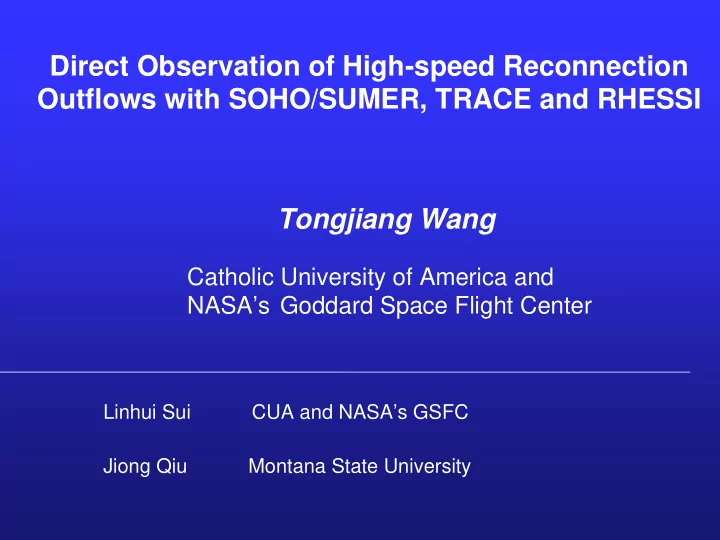

Direct Observation of High-speed Reconnection Outflows with SOHO/SUMER, TRACE and RHESSI Tongjiang Wang Catholic University of America and NASA’s Goddard Space Flight Center Linhui Sui CUA and NASA’s GSFC Jiong Qiu Montana State University
Introduction • Magnetic Reconnection Energy release mechanism for flares and CMEs • Observational Evidence — Separation motion of flare ribbons in H α — Cusp-shaped soft X-ray flare loops (Tsuneta et al. 1992) — Loop-top hard X-ray sources (Masuda et al. 1994) — Double RHESSI X-ray coronal sources (Sui & Holman 2003) ♣ Signature of reconnection inflow by EIT (Yokoyama et al. 2001) ♣ Signature of reconnection outflow: Plasma blob ejections in soft X-rays (Shibata et al. 1995) Dark downward flows in X-ray and EUV (McKenzie & Hudson 1999)
Observations • GOES M2.5-class flare on 2002 April 16, peaked at 13:15 UT — TRACE 195 A EUV images — RHESSI hard X-rays — SOHO/SUMER spectra TRACE difference images Ca X Fe XIX
Coalignments between SUMER and TRACE Coalignment in Y direction (along slit) Coalignment in X direction within ~ 1 arcsec within ~ 2-3 arcsec
Results: upflow and downflow of plasma jets Upper two rows: an upflow with blueshift up to ~600 km/s Bottom row: a downflow with redshift up to ~300 km/s • Life time : upflow ~ 8 min downflow ~ 7 min • Width of jet ~ 6 arcsec
Results: hot high-speed upflow in Fe XIX • During flare impulsive phase • Following eruption of a hot loop • Life time ~ 8 minutes SUMER TRACE 195 • Narrow width ~ 6 arcsec • Doppler shift up to 600 km/s Fe XIX spectra V upflow ~ 1800 – 3500 km/s In jet Before jet If considering the projection effect
Results: Time correlation of jets with hard X-ray peak Time for upflow Time for downflow • High-speed jets are coincided in time with main hard X-ray peak • High-speed jets occur in an interval with low Fe XIX emission, following an erupting loop, and • Time series of Fe XIX intensity preceding the apparently-growing cusp-shaped flare loops Sign of erupting hot Sign of cusp-shaped post-flare loop (flux rope) loops rising across the slit
Results: location of high-speed jets at the magnetic reconnection region — RHESSI Double hard X-ray sources with opposite temperature gradients (Sui & Holman 2003; Sui 2004; Sui, Holman & Dennis 2004;) — High-speed jets were seen after the top of TRACE loop and RHESSI X-ray source passed through the SUMER slit TRACE: difference images RHESSI: green contours SUMER slit: vertical line Speed of outwards moving TRACE loop: V ~ 45 – 75 km/s (Goff et al. 2005)
Discussions: Interpretaions
Discussions • Estimate of the true jet speed by considering the projection effect The angle of jets to LOS ~ 70 – 80 degs, so V jet ~ 1800 – 3500 km/s for V Doppler ~ 600 km/s typical Alfven speed in the corona • Estimate of magnetic field near the reconnection site, V Alfven ~ 3000 (B/20 G) / (Ne/2e8 cm -3 ) 1/2 km/s Given Ne ~ 5 × 10 8 cm -3 and V A ~ V jet ~ 1800 – 3500 km/s obtain B ~ 19 – 37 G
Conclusions • Spatial relationship of high Doppler-shift flows with the reconnection region and temporal correlation of the flows with hard X-ray peak provide direct evidence of high-speed magnetic reconnection outflows in the current sheet in the corona. • The observations lend strong support to the magnetic reconnection theory and the bipolar reconnection model of solar eruptive events (flares and CMEs) Wang et al. 2007 ApJ Letter, 661, L207 Movie dowload: http://solar.physics.montana.edu/wangtj/outflow_mov.gif
Guidance to prospective Hinode/EIS observation for magnetic reconnection in solar flares 1. Locate reconnection region (or current sheet) with imaging obs. Using coordinated RHESSI, high-cadence Hinode/XRT and TRACE 195 A observations to detect the erupting flux rope, coronal source, and cusp- structure etc. 2. Detect reconnection inflow and outflows with EIS Using sparsely, high-cadence (~ 1 min) EIS raster scanning. strong coronal lines, e.g. Fe X - Fe XII to detect Doppler shift of reconnection inflows and measure coronal density near reconnection region Hot lines, e.g., Fe XIV- Fe XVII to detect possible erupting hot flux rope Flare lines, Ca XVII, Fe XXIII, Fe XXIV with enough wide windows to detect high Doppler shifts of reconnection outflows 2” slit, exposure time of 2 s, step size 6”, 10 pointing positions, FOV 60” x 100” 3. Target: near-limb ARs better with sigmoid feature in XRT
Recommend
More recommend